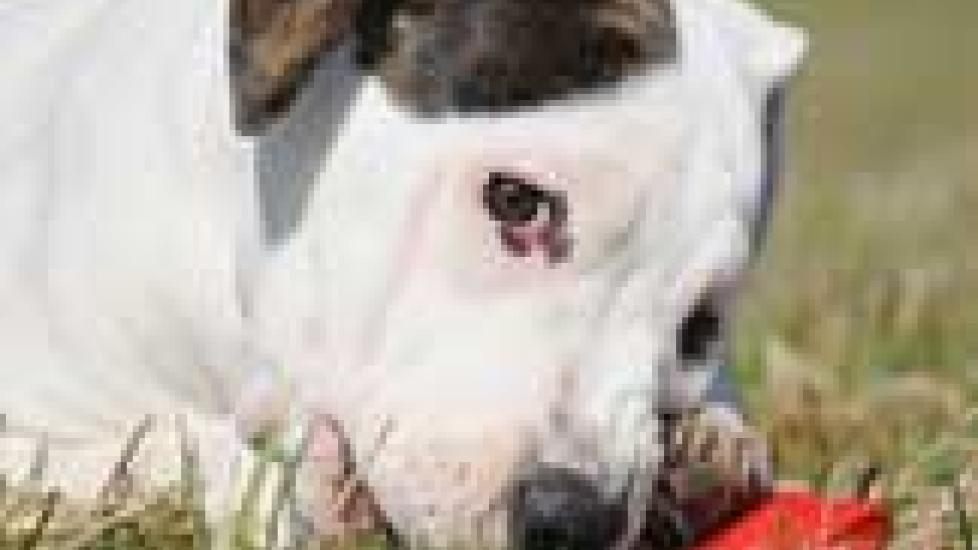Mine! What to do When Your Pup Doesn’t Like to Share
My friend Sue just adopted a 10-month-old, mixed breed dog from the local shelter. She named her Julep. Her head is wide and she’s short and stocky, but her fur is wiry and sticks up all over the place. She’s a nice, cute, friendly dog.
I was hanging out with Sue and Julep a couple of days after she was adopted when I noticed something interesting. Each time Julep got a toy, she ran away with it. Then, she searched frantically for a place — anyplace — to hide the toy. If she couldn’t find a place, she would just stand there staring into space with her toy in her mouth. If we left Julep alone, she would eventually settle down to destroy her toy.
It was clear that Julep had anxiety about people taking her toys. In other words, she was worried that someone would take her stuff, so she had to quickly hide it where only she could find it later.
To remedy this, whenever we saw her calmly chewing a toy, or when she was playing tug with us, we would offer her a treat in trade for the toy. When she would trade it, we wouldn’t take the toy, we would just give her the treat and walk away. What we noticed initially was that she would not trade certain toys even for the very best food. It is clear that Julep loves food, so this was a red flag that her toys were very important to her and that she was at risk for developing Resource Guarding.
Resource Guarding is an anxiety disorder in which the dog guards items that she deems valuable. Resource Guarding can present in any age dog. However, it generally starts in puppyhood. Sometimes the behavior is mild and goes unnoticed until the dog is between 1 and 3 years old, when the owners start to see more overt signs such as growling and biting. In some dogs, Resource Guarding can develop later due to the administration of medications that increase appetite, or after periods of starvation. Regardless of the cause, early identification and proper treatment of puppies who are predisposed to this behavior is very important.
If you think about it, Resource Guarding is not abnormal. If you watch multiple dogs interact, you’ll see that they guard things from each other. So what does it take for a dog to receive the diagnosis of Resource Guarding?
Dogs that are diagnosed with Resource Guarding guard their stuff in an extreme way. They may just guard with more intensity, or they may guard items that seem very unimportant, like paper towels. Many owners force the dog to give up the item; by prying the dog’s mouth open, for example. This causes the dog’s greatest fear to come true: that their stuff is going to be taken away when the owner approaches. Although at that moment the owner has won the battle, she has lost the war. If the dog truly has Resource Guarding, the aggression will intensify because the owner has taught the dog to fear her approach. If a dog is already growling, lunging, snapping or biting, it should be seen by a Board-Certified Veterinary Behaviorist. You can find one at dacvb.org.
As for Julep, we let her be, doing very little work on the issue until she had been in Sue’s house for about a week.
Once Julep had adjusted a little more to her new home, we started working in earnest to teach her that giving her toys back to people was infinitely rewarding. From the day we began, Julep and Sue would from there on live by these rules:
- When a person approached Julep and she had a toy, there was a high likelihood that the person would not take the toy.
- Even if the person took the toy, Julep would probably either (1) get it back immediately, or (2) get something better in return, or get it back and get something better in return.
When Julep had a toy in her mouth or had settled down with it, Sue approached and said, "Drop it." She then immediately offered a treat. If Julep dropped her toy, she got the treat and Sue would let Julep have the toy back. If Julep didn’t drop the toy, Sue tossed a treat to the side and walked away. Julep would always look at us quizzically and then drop the toy in order to eat the treat; then she would go back to pick up her toy.
For the next week or so, every time Sue saw Julep with a toy, she made a trade for a treat. By the end of the week, she no longer had to toss the treat to get her to drop a toy. Instead, she only had to say "Drop it" and show Julep the treat.
Eventually, she will not have to show her the treat, but only say, "Drop it." What is likely to happen in the not-so-distant future is that Julep will see Sue approaching and drop whatever she has in her mouth without any cue whatsoever.
Over the course of Julep’s lifetime, Sue and Julep will have many more interactions over toys, stolen garbage, and found items. If Sue sticks to the rules, Julep most likely will too.

Dr. Lisa Radosta
Image: AnetaPics / via Shutterstock
